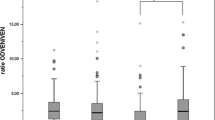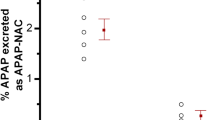Summary
The aims of this study were to evaluate the oxidising phenotype in a random sample of the Italian population and to study the relationships between the phenotype and the pharmacokinetics of propafenone, which is oxidised to 5-hydroxypropafenone.
The urinary debrisoquine: 4-hydroxydebrisoquine ratio was used to characterise the oxidative phenotype in 90 subjects (42 patients with ventricular arrhythmias and 48 healthy volunteers); subjects with ratios higher than 12.6 were defined ‘poor metabolisers’. The pharmacokinetics of propafenone were studied in 10 ‘extensive metabolisers’ of debrisoquine, both after acute and maintenance administration.
The incidence of ‘poor metabolisers’ was 6.6%, similar to that of other studies in Caucasians. Propafenone exibited nonlinear kinetics; the propafenone: 5-hydroxypropafenone ratio and the propafenone half-life were significantly related to the debrisoquine: 4-hydroxydebrisoquine ratio, both after single dose (r = 0.97; r = 0.96, respectively) and maintenance administration (r = 0.99; r = 0.95).
In conclusion, the differences in oxidising capacity observed among ‘extensive me-tabolisers’ markedly influence the kinetics of propafenone with relevant clinical implications.
Similar content being viewed by others
References
Boobis AR, Murray S, Kahn C, Robertz GM, Davies DS. Substrate specificity of the form of cytochrome P-450 catalyzing the 4-hydroxylation of debrisoquine in man. Molecular Pharmacology 23: 474–481, 1983
Brode E, Sachse R, Hoffmann HD. Untersuchungen zur Analytik von Propafenon mittels interner Analogstandardsierung. Arzneimittel Forschung 32: 1–6, 1982
Capucci A, Gubelli S, Carini G, Frabetti L, Magnani B. Cardioversione farmacologica con propafenone di fibrillazione atriale stabile di recente insorgenza. Giornale Italiano di Cardiologia 17: 975–982, 1987
Connolly SJ, Kates RE, Lebsack CS, Harrison DC, Winkle RA. Clinical pharmacology of propafenone. Circulation 68: 589–596, 1983
Connolly S, Lebsack C, Winkle RA, Harrison DC, Kates RE. Propafenone disposition kinetics in cardiac arrhythmia. Clinical Pharmacology and Therapeutics 36: 163–168, 1984
Clark DWJ. Genetically determined variability in acetylation and oxidation: therapeutic implications. Drugs 29: 342–375, 1985
Frabetti L, Marchesini B, Capucci A, Cavallini C, Gubelli S, et al. Antiarrhythmic efficacy of propafenone: evaluation of effective plasma levels following single and multiple doses. European Journal of Clinical Pharmacology 30: 665–671, 1986
Hammill SC, McLaran CJ, Wood DL, Osborn MJ, Gersh BJ, et al. Double blind study of intravenous propafenone for paroxysmal supra ventricular reentrant tachycardia. Journal of the American College of Cardiology 9: 1364–1368, 1987
Hammill SC, Sorenson PB, Wood DL, Sugrue DD, Osborn MJ, et al. Propafenone for the treatment of refractory complex ventricular ectopic activity. Mayo Clinic Proceedings 61: 98–103, 1986
Harrison PM, Tonkin AM, Dixon ST, McLean AJ. Determination of debrisoquine and its 4-hydroxy metabolite in urine by high-performance liquid chromatography. Journal of Chromatography 374: 204–208, 1986
Harron DWG, Brogden RN. Propafenone: a review of its pharmacodynamic and pharmacokinetic properties and therapeutic use in the treatment of arrhythmias. Drugs 34: 617–647, 1987
Hege HG, Hollman M, Kaumeier S, Lietz H. The metabolic fate of 3H-labelled propafenone in man. European Journal of Drug Metabolism and Pharmacokinetics 9: 41–55, 1984
Horai Y, Ishizaki T. Pharmacogenetics and its clinical implications, part II: oxidation polymorphisms. Rational Drug Therapy 22: 1–8, 1988
Islam SI, Idle JR, Smith RL. The polymorphic 4-hydroxylation of debrisoquine in a Saudi Arabian population. Xenobiotica 10: 819–825, 1980
Kalow W. Ethnic differences in drug metabolism. Clinical Pharmacokinetics 7: 373–400, 1982
Kates RE, Yee YG, Winkle RA. Metabolite cumulation during chronic propafenone dosing in arrhythmias. Clinical Pharmacology and Therapeutics 37: 610–614, 1985
Mahgoub A, Idle JR, Dring LG, Lancaster R, Smith RL. Polymorphic hydroxylation of debrisoquine in man. Lancet 2: 584–586, 1977
Mahgoub A, Idle JR, Smith RL. A population and familial study of the defective alicyclic hydroxylation of debrisoquine among Egyptians. Xenobiotica 9: 51–56, 1979
Marchesini B, Tornasi L. Effects of modifiers on the Chromatographic behaviour of propafenone and its major metabolite. Chromatographia 34: 753–758, 1987
Mbanefo C, Bababunmi EA, Mahgoub A, Sloan TP, Idle JR, et al. A study of the debrisoquine hydroxylation polymorphism in a Nigerian population. Xenobiotica 10: 811–818, 1980
Nakamura K, Goto F, Ray WA, McAllister CB, Jacqz E, et al. Interethnic differences in genetic polymorphism of debrisoquine and mephenytoin hydroxylation between Japanese and Caucasian populations. Clinical Pharmacology and Therapeutics 38: 402–408, 1985
Podrid PJ, Cytryn R, Lown B. Propafenone: noninvasive evaluation of efficacy. American Journal of Cardiology 54: 53D–59D, 1984
Price Evans DA, Mahgoub A, Sloan TP, Idle JR, Smith RL. A family and population study on the genetic polymorphism of debrisoquine oxidation in a white British population. Journal of Medical Genetics 17: 102–105, 1980
Siddoway LA, Thompson KA, McAllister B, Wang T, Wilkinson GR, et al. Polymorphism of propafenone metabolism and disposition in man: clinical and pharmacokinetic consequences. Circulation 75: 785–791, 1987
Sloan TP, Lancaster R, Shah RR, Idle JR, Smith RL. Genetically determined oxidation capacity and the disposition of debrisoquine. British Journal of Clinical Pharmacology 15: 443–450, 1983
Steiner E, Iselius L, Alvan G, Lindsten J, Sjoqvist F. A family study of genetic and environmental factors determining polymorphic hydroxylation of debrisoquin. Clinical Pharmacology and Therapeutics 38: 394–401, 1985
Steiner E, Bertilsson L, Sawe J, Bertling I, Sjoqvist F. Polymorphic debrisoquin hydroxylation in 757 Swedish subjects. Clinical Pharmacology and Therapeutics 44: 431–435, 1988
Valenzuela C, Delgado C, Tamargo J. Electrophysiological effects of 5-hydroxypropafenone on guinea pig ventricular muscle fibers. Journal of Cardiovascular Pharmacology 10: 523–529, 1987
Von Philisborn G, Gries J, Hofmann HP, Kreiskott R, Kretzchmar R, et al. Pharmacological studies on propafenone and its main metabolite 5- hydroxypropafenone. Arzneimittel Forschung 34: 1489–1497, 1984
Woolhouse NM, Andoh B, Mahgoub A, Sloan TP, Idle JR, et al. Debrisoquine hydroxylation polymorphism among Ghananians and Caucasians. Clinical Pharmacology and Therapeutics 26: 584–591, 1979
Author information
Authors and Affiliations
Rights and permissions
About this article
Cite this article
Boriarti, G., Strocchi, E., Capucci, A. et al. Relationships Between Debrisoquine Hydroxylation and Propafenone Pharmacokinetics. Drug Invest 2, 114–119 (1990). https://doi.org/10.1007/BF03258249
Published:
Issue Date:
DOI: https://doi.org/10.1007/BF03258249




